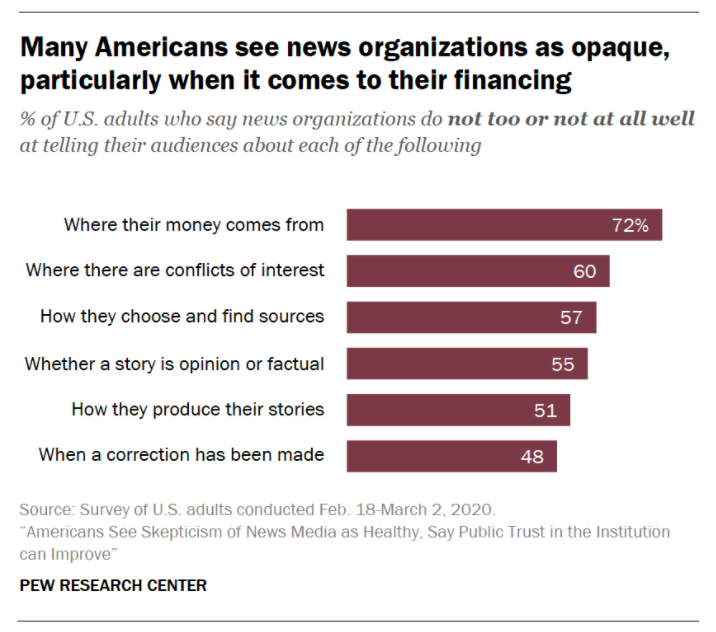If you could build audience trust to the point where you could line each of your readers up and ask them to do a trust fall into your publication’s arms, they should agree to do it in a heartbeat.
Okay, that might be a bit extreme. (No judgement if you had trouble with trust falls in gym class.)
It does, however, illustrate a truly important point: Publishers must be able to cultivate audience trust. Without it, they’ll lose major opportunities to drive engagement and revenue. With it, they’ll be prepared to build and nurture audience relationships with personalized content across channels.

As our own CRO Steve Goldstein said in a recent installment of “Between the Newsstands,” “The more trustworthy the publisher is for the user, the more likely they are to come back and engage with their content.”
With that in mind, let’s take a closer look at just why trust is such a hot commodity for publishers, and how they can better build it to optimize consumer experiences.
Why is trust so important these days?
Audience trust is increasingly hard to come by — thanks in large part to deceptive content widely shared social media platforms and intrusive ad experiences. After Facebook’s data breaches, algorithm changes, and controversies around spreading fake news, it’s no wonder readers are giving a major side-eye to their news sources, and taking any digital content with a big grain of salt.
As Pew Research Center found, over half of adults distrust Facebook. And, among those who get their news from sources like TV and print, half are very concerned about misinformation on social platforms.
Meanwhile Edelman reported that more than over half of U.S. audiences also distrust mainstream media. More specifically, Pew Research Center also reported that audiences want news organizations to be more transparent about their funding, conflicts of interest, sources, and facts.

Apple and Google’s recent initiatives to improve consumer privacy are also indicative of a severe lack of trust and transparency on the web. Google, for example, is getting rid of third-party cookies on its Chrome browsers and Apple is making iOS apps ask users for permission to track and share their data.
All of these developments may seem to spell disaster for publishers, but they actually point to a major opportunity for those who are prepared: Publishers can get ahead of the game by optimizing their strategies to prioritize trust and transparency.

What are the biggest benefits of building audience trust?
“Trust” isn’t just a feel-good word that’s fun to throw around. It can actually have a real-world, monetary value for publishers that know how to cultivate it.
As Goldstein said, “Anyone can get content anywhere on the web — questionable content, questionable landing pages, questionable domains. But when you actually trust a publisher, when you get content from them and you’re engaging with them, you trust who comes along with that.”
Digging in further, here are some of the biggest advantages to building audience trust.
Increase engagement
The more people trust a publication, the more they’re willing to read its content and engage with its messaging. Sure, it sounds like common sense. But the proof is also in the numbers. According to our 2020 survey, 45% of consumers are more likely to read publishers’ emails when they trust the company.
This works the other way around, too. The less users trust a news outlet, the less they’ll use it. As The Guardian reported, Facebook usage plummeted after the Cambridge Analytics data scandal.
Deliver better user experiences
Once users are comfortable engaging with a publisher site, the publisher can then collect their data — with proper approval process and transparency, of course — and use that data to deliver personalized experiences based on each user’s preferences and behaviors. As our study found, 61% of consumers are okay with companies tracking their online behavior as long as they trust the company.
As a result, publishers get to learn more about their audiences and audiences get to enjoy more valuable, relevant content.
Generate revenue
Now let’s talk about the bottom line. Since trust yields engagement, that also includes engagement with ads. According to our study, two-thirds of consumers will click on an ad if it’s delivered from a publication they trust. Those clicks generate revenue for publishers, especially if they come from ads that are personalized to each reader’s interests.
As Goldstein said, “Ads that sit on trusted publishers’ pages tend to get clicked more often, tend to drive up the monetization aspect of things, and, more importantly, users see benefit in that. They love the content they read — relevant ads along with it — they engage with it, they tend to purchase more. So it’s a win-win for everybody involved.”
How can publishers build audience trust?
The merits of building audience trust are clear. The question now is, how do you garner that trust for your publication and start to reap those benefits for yourself?
Let’s take a look:
- Stop relying on third-party social platforms. Facebook and Twitter might promise quick hits, but they’re untrusted by consumers and will only hold your data captive inside walled gardens. Since you can only use social and search to tap into third-party audiences, they’re also not the answer to harnessing deep engagement opportunities and nurturing audience relationships.
- Invest in trustworthy channels. Instead, you should prioritize one-to-one channels like email and push notifications that are proven to be trustworthy and engaging.
- Gather your own first-party data. On these opt-in channels, you can begin to collect high-quality data — like email addresses — directly from your consumers. You can then use that first-party data to responsibly track and target audiences across platforms. Just remember to ask your readers for permission and be transparent about how their data will be utilized.
Increase trust and revenue
Jeeng understands the importance of audience trust. That’s why we built a platform that empowers publishers to take control of their data and reach consumers across the most trustworthy channels on the web. Whether you want to launch campaigns via email, push notifications, or news reader apps, you need to first garner the trust of your readers. Only then can you gather their information, reach them with personalized messaging, and drive revenue.
We have the tools and strategies to help make that happen.
Contact us now to get started.


